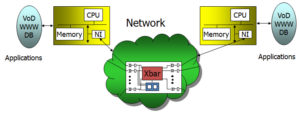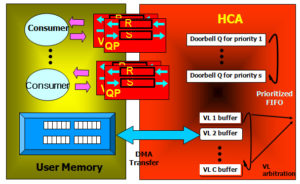Clusters have been widely accepted as the most effective solution to design high performance servers, which are increasingly being deployed in supporting a wide variety of Web-based services. Along with high and predictable performance, optimization of energy consumption in these servers has become a serious concern due to their high power budgets. In addition, the critical nature of many Internet-based services mandates that these systems should be robust to attacks from the Internet, since numerous security loopholes of cluster servers have been revealed. Although some initial investigation on cluster energy consumption and security has appeared recently, an in-depth design and analysis of a cluster interconnect considering the three parameters mentioned above have not been undertaken.

Performance analysis of a QoS capable cluster interconnect
The growing use of clusters in diverse applications, many of which have real-time constraints, requires quality-of-service (QoS) support from the underlying cluster interconnect. All prior studies on QoS-aware cluster routers/networks have used simulation for performance evaluation. In this work, we present an analytical model for a wormhole-switched router with QoS provisioning. In particular, the model captures message blocking due to wormhole switching in a pipelined router, and bandwidth sharing due to a rate-based scheduling mechanism, called VirtualClock. Then we extend the model to a hypercube-style cluster network. Average message latency for different traffic classes and deadline missing probability for real-time applications are computed using the model. We evaluate a 16-port router and hypercubes of different dimensions with a mixed workload of real-time and best-effort (BE) traffic. Comparison with the simulation results shows that the single router and the network models are quite accurate in providing the performance estimates, and thus can be used as efficient design tools.
Performance Enhancement Techniques for InfiniBand Architecture
InfiniBand Architecture (IBA) is envisioned to be the default communication fabric for system area networks (SANs). However, the released IBA specification outlines only higher level functionalities, leaving it open for exploring various design alternatives. In this work, we investigate four co-related techniques to provide high and predictable performance in IBA. These are: (i) using the Shortest Path First (SPF) algorithm for deterministic packet routing; (ii) developing a multipath routing mechanism for minimizing congestion; (iii) developing a selective packet dropping scheme to handle deadlock and congestion; and (iv) providing multicasting support for customized applications. These designs are evaluated using an integrated workload on a versatile IBA simulation testbed. Simulation results indicate that the SPF routing, multipath routing, packet dropping, and multicasting schemes are quite effective in delivering high and assured performance in clusters. One of the major contributions of this research is the IBA simulation testbed, which is an essential tool to evaluate various design tradeoffs.
Infiniband Architecture

Energy-Efficient Cluster Interconnects
Designing energy-efficient clusters has recently become an important concern to make these systems economically attractive for many applications. Since the cluster interconnect is a major part of the system, the focus of this work is to characterize and optimize the energy consumption in the entire interconnect. Using a cycle-accurate simulator of an InfiniBand Architecture (IBA) compliant interconnect fabric and actual designs of its components, we investigate the energy behavior on regular and irregular interconnects. The energy profile of the three major components (switches, network interface cards (NICs), and links) reveals that the links and switch buffers consume the major portion of the power budget. Hence, we focus on energy optimization of these two components. To minimize power in the links, first we investigate the dynamic voltage scaling (DVS) algorithm and then propose a novel dynamic link shutdown (DLS) technique. The DLS technique makes use of an appropriate adaptive routing algorithm to shutdown the links intelligently. We also present an optimized buffer design for reducing leakage energy in 70nm technology. Our analysis on different networks reveals that while DVS is an effective energy conservation technique, it incurs significant performance penalty at low to medium workload. Moreover, energy saving with DVS reduces as the buffer leakage current becomes significant with 70nm design.On the other hand, the proposed DLS technique can provide optimized performance-energy behavior (up to 40% energy savings with less than 5% performance degradation in the best case) for the cluster interconnects.
Papers
- K. H. Yum, Y. Jin, E. J. Kim, and C. R. Das, “Integration of Admission, Congestion, and Peak Power Control in QoS-Aware Clusters,” to appear in The Journal of Parallel and Distributed Computing (JPDC).
- E. J. Kim, K. H. Yum, C. R. Das, M. Yousif, and J. Duato, “Exploring IBA Design Space for Improved Performance,” IEEE Transactions on Parallel and Distributed Systems (TPDS), Vol. 18, No. 4, pp. 498-510, April 2007 (pdf).
- E. J. Kim, G. M. Link, K. H. Yum, V. Narayanan, M. Kandemir, M. J. Irwin, C. R. Das, “A Holistic Approach to Designing Energy-Efficient Cluster Interconnets,” IEEE Transactions on Computers, Vol. 54, No. 6, pp. 660-671, June 2005. (pdf)
- E. J. Kim, K. H. Yum, and C. R. Das, “Performance Analysis of a QoS Capable Cluster Interconnect,” Performance Evaluation, Volume 60, Issues 1-4, pp. 275-302, May 2005.
